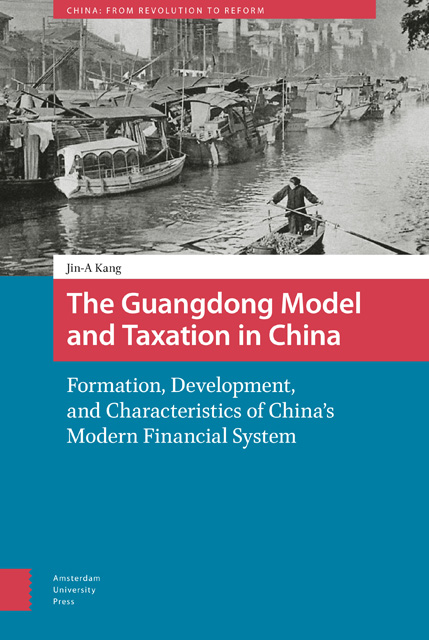 The Guangdong Model and Taxation in China
The Guangdong Model and Taxation in China Published online by Cambridge University Press: 10 January 2023
Abstract
From the late Qing to the 1920s, abolition of the likin was always a priority on the Chinese tax reform agenda. The newly established Nationalist Government in Nanjing finally announced the policy of “abolishing the likin and creating a new tax” in conjunction with restoring tariff sovereignty. This chapter examines how the Guangdong provincial government responded to the central government's policy by focusing on creating the Special Tax. The Chen Jitang separatist regime in Guangzhou responded to preemptively abolishing the likin and miscellaneous taxes and reinventing the special tax as a kind of local tariff instead. The special tax became the largest source of financial revenue in Guangdong province through the 1930s.
Keywords: Special Tax, Guangdong, local tariff, China
From the late Qing to the 1920s, abolition of the likin was always a priority on the Chinese tax reform agenda. But it was not until the establishment of the Nanjing Nationalist Government (hereafter NNG) that the policy of “abolishing the likin and creating a new tax” (caili jiashui) was implemented in conjunction with the restoration of tariff sovereignty. The NNG secured high-revenue income by raising the tariff rate instead of promising abolition of the likin from the Western powers. To compensate for the loss of expected revenue loss due to the abolition of the likin, the NNG allocated land taxes to the local governments. However, Guangdong province, which was already highly commercialized, could not match the loss of the likin with gains from the land tax. This chapter examines how the Guangdong provincial government (hereafter, the GPG) responded to the central government's policy to abolish the likin in the 1930s by focusing on the creation of the “special tax.”
The origins of the special tax: Between the likin and tariffs
The special tax was a local tariff on foreign goods transferred to Guangdong province. However, in reality it was more complicated. First, it had the nature of a tariff in that it targeted imported goods. Second, it had the nature of the likin in that domestic cargo from other provinces could also be subject to this taxation.
To save this book to your Kindle, first ensure [email protected] is added to your Approved Personal Document E-mail List under your Personal Document Settings on the Manage Your Content and Devices page of your Amazon account. Then enter the ‘name’ part of your Kindle email address below. Find out more about saving to your Kindle.
Note you can select to save to either the @free.kindle.com or @kindle.com variations. ‘@free.kindle.com’ emails are free but can only be saved to your device when it is connected to wi-fi. ‘@kindle.com’ emails can be delivered even when you are not connected to wi-fi, but note that service fees apply.
Find out more about the Kindle Personal Document Service.
To save content items to your account, please confirm that you agree to abide by our usage policies. If this is the first time you use this feature, you will be asked to authorise Cambridge Core to connect with your account. Find out more about saving content to Dropbox.
To save content items to your account, please confirm that you agree to abide by our usage policies. If this is the first time you use this feature, you will be asked to authorise Cambridge Core to connect with your account. Find out more about saving content to Google Drive.